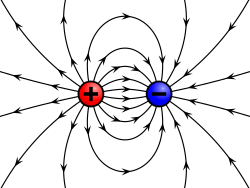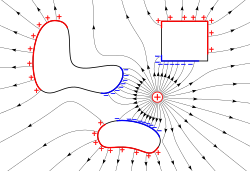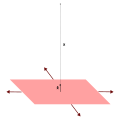Electric field
| Electromagnetism |
|---|
 |
| Electricity · Magnetism · Magnetic permeability |
An electric field is a vector field that shows the direction that a positively charged particle will move when placed in the field. More precisely, if a particle has an electric charge [math]\displaystyle{ q }[/math] and is in an electric field [math]\displaystyle{ \vec{E} }[/math], the electric force the charge will feel is [math]\displaystyle{ \vec{F}=q\cdot \vec{E} }[/math]. Electric fields are produced around objects that have electrical charge, or by a magnetic field that changes with time. Electric field lines are used to represent the influence of electric field. [1] The idea of an electric field was first made by Michael Faraday.[2]
Electric fields are caused by electric charges, described by Gauss's law,[3] or varying magnetic fields, described by Faraday's law of induction.[4] The equations of both fields are coupled and together form Maxwell's equations that describe both fields as a function of charges and currents.[5]
Electric Field Media
Electric field of a positive point electric charge suspended over an infinite sheet of conducting material. The field is depicted by electric field lines, lines which follow the direction of the electric field in space. The induced charge distribution in the sheet is not shown.
Illustration of the electric field between two parallel conductive plates of finite size (known as a parallel plate capacitor). In the middle of the plates, far from any edges, the electric field is very nearly uniform.
The electric field (lines with arrows) of a charge (+) induces surface charges (red and blue areas) on metal objects due to electrostatic induction.
Related pages
References
- ↑ Richard Feynman (1970). The Feynman Lectures on Physics Vol II. Addison Wesley Longman. ISBN 978-0-201-02115-8.
- ↑ "Michael Faraday". Archived from the original on 2021-05-20. Retrieved 2015-06-30.
- ↑ Purcell, p 25: "Gauss's Law: the flux of the electric field E through any closed surface... equals 1/e times the total charge enclosed by the surface."
- ↑ Purcell, p 356: "Faraday's Law of Induction."
- ↑ Purcell, Edward & Morin, David 2013. Electricity and magnetism. 3rd ed, Cambridge University Press. New York. ISBN 978-1-107-01402-2
+{{{1}}}−{{{2}}}








